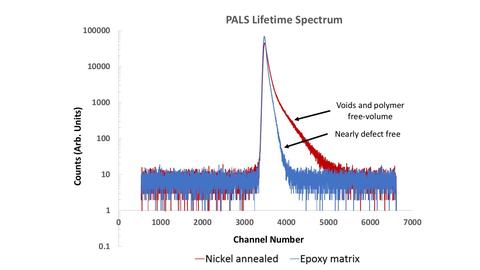Novel Measurement Tools for Interrogating Structure-Property Relationships in High Performance Materials
High-performance materials have unique properties that require the development of novel measurement methods to understand their structure-property relationships and how these relationships change with material lifetime, exposure, or condition. We have two major efforts underway towards the development of these new characterization methods. The first is the use of positron annihilation lifetime spectroscopy (PALS), which is based on the principle that a positron will emit a gamma ray through annihilation with an electron. These gamma rays are detected, and the delay between emission of the positron and the detection of the gamma ray determined. This delay is related to the lifetime of the positron, which is in turn related to the voids in the material. Thus, this technique can provide information on the voids within a material. Development of a benchtop positron annihilation lifetime spectrometer has been underway in our laboratory since 2015.
Results: We have performed a series of validation experiments on pure metals to understand the response of the equipment. We are currently testing nanocomposite materials and expect to release two publications soon, one describing procedures for validating a benchtop PALS setup, and one summarizing the results of our nanocomposite characterization.
The effects of temperature and strain-rate on the mechanical properties of Ultra High Molar Mass Polyethylene (UHMMPE) single fibers are being investigated at eleven temperatures, ranging from room temperature (20 °C) to the orthorhombic-hexagonal phase transition (148 °C), and at six strain-rates, ranging from quasi-static to dynamic, using specially designed equipment to mechanically test fibers at these different combinations of temperature and strain rate. Dimensional analysis of ballistic limit tests using the (U*)1/3 has shown an underperformance relative to theoretical calculations of materials comprising UHMMPE fibers. A possible explanation is the relatively low melting temperature of UHMMPE fibers (~150 °C) in comparison to that of other fiber materials, such as poly-aramids (~450 °C), which will be investigated through this work. This project has been underway since late 2014.
Some preliminary results of this work can be found in the following publication:

Figure 1: A typical comparison of an annealed nickel specimen, which is nearly defect free, and an epoxy specimen, which is known to have voids and free volume, using positron annihilation lifetime spectroscopy. The spectra here can be fitted to determine the void size in the polymer material.
Contacts
-
(301) 975-5632
Collaborators
-
(301) 975-6065

